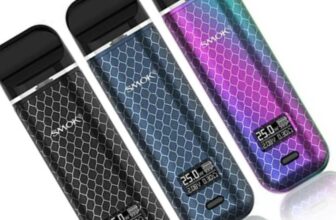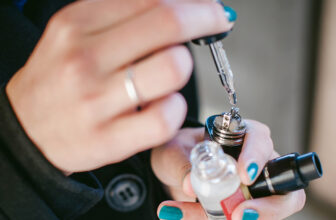
Propylene glycol also known as PG.
Propylene glycol, also called 1,2-propanediol or propane-1,2-diol, is an organic compound (a diol or double alcohol) with formula C3H8O2 or HO-CH2-CHOH-CH3. It is a colorless, nearly odorless, clear, viscous liquid with a faintly sweet taste, hygroscopic and miscible with water, acetone, and chloroform.
The compound is sometimes called α-propylene glycol to distinguish it from the isomer propane-1,3-diol HO-(CH2)3-OH, also called β-propylene glycol.
Chirality
Propylene glycol contains an asymmetrical carbon atom, so it exists in two stereoisomers. The commercial product is a racemic mixture. Pure optical isomers can be obtained by hydration of optically pure propylene oxide.[2]
[edit] Production
Industrially propylene glycol is produced from propylene oxide.[3] Different manufacturers use either non-catalytic high-temperature process at 200 °C (392 °F) to 220 °C (428 °F), or a catalytic method, which proceeds at 150 °C (302 °F) to 180 °C (356 °F) in the presence of ion exchange resin or a small amount of sulfuric acid or alkali.
Final products contain 20% 1,2-propanediol, 1.5% of dipropylene glycol and small amounts of other polypropylene glycols.[4] Further purification produces finished industrial grade or USP/JP/EP/BP grade propylene glycol that is typically 99.5% or greater. Propylene glycol can also be converted from glycerol, a biodiesel byproduct.
Propylene glycol is used:
As a solvent in many pharmaceuticals, including oral, injectable and topical formulations. Notably, diazepam, which is insoluble in water, uses propylene glycol as its solvent in its clinical, injectable form.[5]
As a humectant food additive, labeled as E number E1520
As an emulsification agent in Angostura and orange bitters
As a moisturizer in medicines, cosmetics, food, toothpaste, shampoo, mouth wash, hair care and tobacco products
As a carrier in fragrance oils
As an ingredient in massage oils
In hand sanitizers, antibacterial lotions, and saline solutions
In smoke machines to make artificial smoke for use in firefighters’ training and theatrical productions
In electronic cigarettes, as a vaporizable base for diluting the nicotine liquid
As a solvent for food colors and flavorings
As an ingredient, along with wax and gelatin, in the production of paintballs
As a moisture stabilizer (humectant) for snus (Swedish style snuff).
As a cooling agent for beer and wine glycol jacketed fermentation tanks
As a non-toxic antifreeze for winterizing drinking water systems, and in applications where the used antifreeze eventually will be drained into the soil, water, or a septic system.[6]
As a less-toxic antifreeze in solar water heating systems
As a solvent used in mixing photographic chemicals, such as film developers
In cryonics
As a working fluid in hydraulic presses
As a coolant in liquid cooling systems
To regulate humidity in a cigar humidor
As the killing and preserving agent in pitfall traps, usually used to capture ground beetles
As an additive to pipe tobacco to prevent dehydration.
To treat livestock ketosis
As the main ingredient in deodorant sticks.
To de-ice aircraft.[7]
As an ingredient in UV or blacklight tattoo ink
As a lubricant in air conditioning compressors.
As a wetting agent, used to determine drying time in paints and coatings
Propylene glycol has properties similar to those of ethylene glycol (monoethylene glycol, or MEG). (Note: Infrequently propylene glycol may also use the acronym MEG, but as an abbreviation of methyl ethyl glycol- the industry standard acronym for propylene glycol is PG or MPG (monopropylene glycol)). The industrial norm is to replace ethylene glycol with propylene glycol when safer properties are desired.
Safety
The acute oral toxicity of propylene glycol is very low, and large quantities are required to cause perceptible health damage in humans; propylene glycol is metabolized in the human body into pyruvic acid (a normal part of the glucose-metabolism process, readily converted to energy), acetic acid (handled by ethanol-metabolism), lactic acid (a normal acid generally abundant during digestion),[9] and propionaldehyde.[10][11] Serious toxicity generally occurs only at plasma concentrations over 1 g/L, which requires extremely high intake over a relatively short period of time.[12] It would be nearly impossible to reach toxic levels by consuming foods or supplements, which contain at most 1 g/kg of PG. Cases of propylene glycol poisoning are usually related to either inappropriate intravenous administration or accidental ingestion of large quantities by children.[13] The potential for long-term oral toxicity is also low. In one study, rats were provided with feed containing as much as 5% PG in feed over a period of 104 weeks and they showed no apparent ill effects.[14] Because of its low chronic oral toxicity, propylene glycol was classified by the U. S. Food and Drug Administration as “generally recognized as safe” (GRAS) for use as a direct food additive.
Prolonged contact with propylene glycol is essentially non-irritating to the skin. Undiluted propylene glycol is minimally irritating to the eye, and can produce slight transient conjunctivitis (the eye recovers after the exposure is removed). Exposure to mists may cause eye irritation, as well as upper respiratory tract irritation. Inhalation of the propylene glycol vapors appears to present no significant hazard in ordinary applications. However, limited human experience indicates that inhalation of propylene glycol mists could be irritating to some individuals. Therefore inhalation exposure to mists of these materials should be avoided. Some research has suggested that propylene glycol not be used in applications where inhalation exposure or human eye contact with the spray mists of these materials is likely, such as fogs for theatrical productions or antifreeze solutions for emergency eye wash stations.[15]
Propylene glycol does not cause sensitization and it shows no evidence of being a carcinogen or of being genotoxic.[16][17]
Adverse responses to intravenous administration of drugs which use PG as an excipient have been seen in a number of people, particularly with large dosages thereof. Responses may include “hypotension[,] bradycardia… QRS and T abnormalities on the ECG[,] arrhythmia[,] cardiac arrest[,] serum hyperosmolality[,] lactic acidosis[,] and haemolysis”.[18] A high percentage (12% to 42%) of directly-injected propylene glycol is eliminated/secreted in urine unaltered depending on dosage, with the remainder appearing in its glucuronide-form. The speed of renal filtration decreases as dosage increases,[19] which may be due to propylene glycol’s mild anesthetic / CNS-depressant -properties as an alcohol.[20] In one case, administration via IV of PG-suspended nitroglycerin to an elderly man may have induced coma and acidosis.[21]
According to a 2010 study by Karlstad University, the concentrations of PGEs, propylene glycol and glycol ethers in indoor air, particularly bedroom air, has been linked to increased risk of developing numerous respiratory and immune disorders in children, including asthma, hay fever, eczema, and allergies, with increased risk ranging from 50% to 180%. This concentration has been linked to use of water-based paints and water-based cleansers.[22][23][24]
[edit] Animals
Propylene glycol is an approved food additive for dog food under the category of animal feed and is generally recognized as safe (GRAS[25]) for dogs.[26] Similarly, propylene glycol is an approved food additive for human food as well.[27] The exception is that it is prohibited for use in food for cats because of a species-specific reaction in the body, as noted in 21 CFR 582.1666.
Veterinary data indicate that propylene glycol is toxic to dogs with a 50% chance of being lethal at doses of 9mL/kg, although the figure is higher for most laboratory animals (LD50 at levels of 20mL/kg).[28]
However, propylene glycol may be toxic to cats in ways not seen in other animals. The U.S. Food and Drug Administration has determined that its presence in or on cat food has not been shown by adequate scientific data to be safe for use. Any such use is considered an adulteration of the cat food and a violation of the Federal Food, Drug, and Cosmetic Act.[29]
[edit] Allergic reaction
Research has suggested that individuals who cannot tolerate propylene glycol probably experience a special form of irritation, but that they only rarely develop allergic contact dermatitis. Other investigators believe that the incidence of allergic contact dermatitis to propylene glycol may be greater than 2% in patients with eczema.[30]
Patients with vulvodynia and interstitial cystitis may be especially sensitive to propylene glycol. Women struggling with yeast infections may also notice that some OTC creams can cause intense burning.[31] Post menopausal women who require the use of an estrogen cream may notice that brand name creams made with propylene glycol often create extreme, uncomfortable burning along the vulva and perianal area. In these cases, patients can request that a local compounding pharmacy make a “propylene glycol free” cream.
Additionally, some electronic cigarette users who inhale propylene glycol vapor may experience dryness of the throat or shortness of breath . As an alternative, some suppliers will put Vegetable Glycerin in the “e-liquid” for those who are allergic (or have bad reactions) to propylene glycol.
Important correction, november 2010: Recent findings in a Swedish study strongly suggests a connection between air-concentrations of propylenglycol in houses and development of asthma and allergic reactions as rhinitis, in children. (Choi, Schmidbauer m.fl. (“010): Common Household Chemicals and the Allergy Risks in Pre-School Age Children. PLoS ONE 5(10): e13423, doi:10.1371/journal.pone.0013423.)
[edit] Possible air germicide
Studies conducted in 1942 by Dr. Oswald Hope Robertson of University of Chicago’s Billings Hospital showed vaporized propylene glycol inhalation in laboratory mice may prevent pneumonia, influenza, and other respiratory diseases. Additional studies in monkeys and other animals were undertaken to determine longterm effects, especially the potential for accumulation in the lungs. After a few months of treatment, no ill effects were discovered.[32]
[edit] Environmental
Propylene glycol is known to exert high levels of biochemical oxygen demand (BOD) during degradation in surface waters. This process can adversely affect aquatic life by consuming oxygen aquatic organisms need to survive. Large quantities of dissolved oxygen (DO) in the water column are consumed when microbial populations decompose ethylene glycol.
The oxygen depletion potential of airport deicing operation discharges is many times greater than that of raw sewage. For example, before application, Type I propylene glycol-based deicing fluid is generally diluted to a mixture containing approximately 50% propylene glycol. Pure propylene glycol has a five-day biochemical oxygen demand (BOD5) concentration of approximately 1,000,000 mg/L. A typical diluted propylene-based deicing fluid could therefore have a BOD5 concentration of approximately 500,000 mg/L. In comparison, raw sewage typically has a BOD5 concentration of approximately 200 mg/L. The amount of fluid used to deice a single jet depends on the nature of the precipitation event and the size of the aircraft but can range from several hundred to several thousand gallons. Therefore, deicing a single jet can generate a BOD5 load greater than that of one million gallons of raw sewage. A large hub airport often has several hundred flights each day.
Sufficient DO levels in surface waters are critical for the survival of fish, macroinvertebrates, and other aquatic organisms. If oxygen concentrations drop below a minimum level, organisms emigrate, if able and possible, to areas with higher oxygen levels or eventually die. This effect can drastically reduce the amount of usable aquatic habitat. Reductions in DO levels can reduce or eliminate bottom-feeder populations, create conditions that favor a change in a community’s species profile, or alter critical food-web interactions.
From Wikipedia, the free encyclopedia








Wow! Very informative. I admit being pretty curious about this. Thank you!
Thanks for sharing.